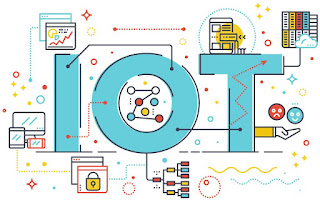Impact of IOT and AI in the field of IT
Impact of IOT and AI in the field of IT
The introduction of smart devices has revitalized the field of Information technology or IT in the last two decades. Where previously, people knew nothing about smartphones, smart TV’s, smart glass, fitness trackers, Google voice, robots etc, now we can observe that these devices are present in every home, business and in possession of the whole population. These devices make use of IOT and AI.
So what exactly does Internet of Things or IOT mean?
Internet of Things, or IOT, is the whole system where physical objects or hardware collect data via sensors. These devices include everyday electronic devices like watches, gadgets, toasters, fitness trackers, fridges, TVs, Projectors, automatic doors, and the list just goes on where IOT is used in devices. These objects are connected to other computing devices or networks that can read this data and transform it into useful piece of information, and sometimes take automatic action.
This means that connectivity and computing has extended to ordinary objects and sensors, which are normally not considered a part of IT. These smart IOT devices can generate, exchange, pass and consume data effectively.
Advantages of IOT
By using IOT we can collect valuable data, data that can’t be collected manually by humans. Mechanical and digital machines, objects, animals or people are provided with unique identifiers (UIDs) where data collection is made possible. This is why IOT has a lot of promise in the field of IT. There are billions of devices in homes, factories, oil wells, hospitals, cars, and thousands of other places. With such a spread of devices, we increasingly need solutions to connect them, and collect, store, and analyze device data. IOT solutions create efficiency, by making interactions with devices more appropriate. The end result is more intuitive and responsive devices, just what we need in the current era of IT.
Impact of IOT
The Internet of Things is an emerging topic of technical, social, and economic significance. But mostly, IOT is centered on consumer-facing products, to facilitate us as consumers in our daily routines. But IOT is also changing the way industries work. The industry is constantly under pressure to increase output as global demands continue to grow. We are advancing towards a fast paced world where IOT is an important part of our daily routines, where it can take care of matters where human-to-human or human-to-computer interaction is not possible.
Professionals in IT are anticipating as many as 100 billion connected IOT devices and a global economic impact of more than $11 trillion by 2025.Everyday objects are being combined with Internet connectivity and powerful data analytic capabilities using IOT that promise to transform the way we work, live, and play. Projections for the impact of IOT on the Internet and economy are impressive.
A hyper connected world and interconnected world of IT is on its way. IOT is fulfilling and advancing the purpose of the Internet architecture itself, which allows unlimited possibilities in the applications and use in IT.
Example of IOT
Take the example of Ultrasound Machines. Before 2000, these are fairly rare, but now they can be seen in every hospital, clinic and maternity ward etc. An ultrasound machine with IOT makes images so that organs inside the body can be examined. The machine sends out high-frequency sound waves, which reflect off body structures. A computer receives the waves and uses them to create a picture. These OIT devices have many forms, sizes and versions. An ultrasound machine on its own can’t make sense of that data, because it is in the form of sound waves. It isn’t particularly useful. In fact, if you looked at the raw data it won’t show you the desired structures of the body. Once this IOT device has collected the above data, that data is passed through various algorithms, and then presented back to the doctor as useful information, in the form of ultrasound images. The naked human eye cannot observe the inside of the body yet by use of IOT in it, is a fully-connected successful IOT solution is provided.
Disadvantages of IOT
IOT raises significant challenges for IT like the hacking of Internet-connected devices, surveillance concerns, and privacy fears. These IOT fears have already have captured public attention. Technical challenges remain and new policy, legal and development challenges are emerging.
So What is Artificial Intelligence or AI?
Artificial intelligence or AI deals with the area of IT that emphasizes the creation of intelligent machines that work and react like humans. The features of AI design are giving IT devices the, speech recognition, learning, planning and problem solving.
Example of AI
There are many cases where machines can use AI to become more intelligent. The Consumer Electronics industry in Bedford, Mass makes great use of AI. They have created a smart robotic vacuum. The vacuum uses AI or artificial intelligence to scan room size, identify obstacles and remember the most efficient routes for cleaning. The self-deploying AI vacuum can also determine how much vacuuming there is to do based on a room's size, and it needs no human assistance to clean floors. This is the successful AI solution to facilitate us.
Impact of AI with IOT
AI and IOT meet to make autonomous decisions faster and better, and you can also make devices smarter, even without Internet connectivity. The intersection of AI and IOT presents new opportunities to create value for any business, capturing new insights from the vast amounts of IOT data available, which results in new efficiencies. A Global study suggests that by 2030, intelligent agents and robots using AI could eliminate as much as 30 percent of the world’s human labor. Artificial Intelligence (AI) and Automation will transform our world.
Keywords
Keywords
IOT 30
AI 12
IT 12
Total Words 961


Comments
Post a Comment